Spatial Distribution of Freshippo Villages under the Digitalization of New Retail in China
Abstract
1. Introduction
1.1. Freshippo Villages under the Digitalization of New Retail
1.2. Literature on the Spatial Distribution of Villages in China
1.3. Structure and Highlights
- We find several important distribution zones of typical digital agricultural economies in China.
- We propose that products and markets are still factors of a digital agricultural economy.
- We discuss the spatial effect on agricultural villages under the digitalization of new retail from spatial distributions and factors.
2. Materials and Methods
2.1. Materials
2.2. Methods
2.2.1. Kernel Density Estimation
2.2.2. Linear Regression Analysis
3. Results
3.1. Spatial Distribution of Freshippo Villages
3.1.1. Regional Features
- The Yangtze River Delta has dozens of Freshippo villages, and their clustering is prominent. As a unique polarized single core, local regional density values can reach 4.5, which is significantly higher than the density of other regions and nearly three times the overall average density. In addition to bamboo shoots produced in Zhejiang, other agricultural products supplied by Southern Freshippo villages mostly comprised daily fresh fruits and vegetables, such as strawberries, watermelons, leafy vegetables, etc. In addition, Freshippo stores began in Shanghai, and most Freshippo stores are gathered here, which can attract the local construction of Freshippo villages.
- Shandong and Hubei are important clustering areas of Freshippo villages. The density in Shandong increased to 1.5, where a cluster of administrative Freshippo villages is emergent in Zibo. This is because the construction of Freshippo cities in Zibo is driven by local governments based on prior natural Freshippo villages. Hubei has a cluster of natural Freshippo villages in Wuhan and surrounding areas with a density of more than 1.5. The Freshippo village named “Qiangxin fruit-Baiquan” made a significant contribution during the epidemic in 2020, which was awarded by the United Nations. Sichuan has a major clustering area of Freshippo villages in the west, and its regional density is up to 2; the first Freshippo village, named Bake, was constructed here, and many agricultural plateaus were developed here.
- There are also some areas that have several non-clustered Freshippo villages, such as the southwest region. In addition, many single points are scattered in some provinces. Increased multi-cores and points with respect to Freshippo villages result in more diverse spatial distributions and richer spatial levels. On the one hand, this shows that Freshippo villages exhibit a spatial generalization development trend; on the other hand, it shows that the industrial agglomeration effect is normalized.
3.1.2. Global Features
- From the latitude, it can be observed that the concentration of Freshippo villages in the middle latitude belt is more significant, and it is connected from east Shanghai to west Sichuan. The other two less significant latitude belts include the 40° N latitudinal belt from east Liaoning to west Xinjiang and a lower-latitude belt from Guangdong to Yunnan. The two longitude belts include the eastern coastal distribution belt and the longitudinal belt of the Heihe–Tengchong Line from Shanxi to Yunnan. The structures of one latitude belt and two longitude belts make up the main spatial distribution framework, including the eastern coastal distribution belt, the longitudinal belt of the Heihe–Tengchong Line, and the 30° N latitudinal belt along the Yangtze River. They are all near the boundary line of two climate areas, so they can be named cross-climate areas or the area of climate boundary [46].
- Spatial distributions tend to mesh locally, forming a polygon with these distribution belts as the edge. The spatial structure—from a point to a belt and then to the emergence of a network distribution—shows that the spatial distribution of the digital agricultural economy in rural areas entered a formation period with respect to national networks. The spatial distribution generally met the Heihe–Tengchong Line, with the exception of a breakthrough in Sichuan [21]. In addition, the spatial distribution also conformed to the south–north distribution with the Boxing line, where there are a similar number of villages [47].
3.2. Statistical Analysis of the Correlation between Freshippo Villages
3.2.1. Correlation of Freshippo Villages and Agricultural Products
- Grain crops
- 2.
- Fruits and vegetables
3.2.2. Correlation between Freshippo Villages and Freshippo Stores
3.2.3. Comparative Analysis of the Correlations of Freshippo Villages
4. Discussion
5. Conclusions
- Freshippo villages have regional clustering features, where spatial cores are mainly shown in several spatial clustering areas by using the KDE method: Yangtze River Delta, Shandong, Hubei, and Sichuan. Located within the main agricultural production regions, these spatial cores indicate the importance of agricultural geographical locations. In addition, new agriculture and increased digitalization result in a local shift in spatial cores.
- Freshippo villages are mainly located in the south and form three main distribution belts in cross-climate areas: the eastern coastal distribution belt, the distribution belt of the Heihe–Tengchong Line, and the 30° N distribution belt along the Yangtze River. In line with the distribution of all villages, the Heihe–Tengchong Line as an important boundary is still suitable for Freshippo villages that apply digital agriculture. The current small gap between the east and the west exhibits digitalization inclusiveness by passing through geographic distances.
- The cross-regional distribution of Freshippo villages forms a new development space with respect to the digital agricultural economy and reconstructs a geographical spatial distribution pattern of the new modern agricultural economy. The important reason for a cross-regional economic model is the shortened geographical response distance. The digitalization of new retail improves agricultural supply–demand modernization and currently results in a wider distribution, which opens up a new virtual–real integrated geographical space, expands the meaning of economic geography, and gives new spatial meanings to the areas of climate boundaries.
- The further provincial statistical analysis of the correlation of Freshippo villages based on the linear regression method shows a higher ratio of gradient/y-intercepts and a higher correlation coefficient with respect to Freshippo stores, fruits, and vegetables than when compared with grain, which indicates that agricultural products and markets are still two important factors of a digital agricultural economy. The complementary agriculture product and market are effective cases for observing the importance of agriculture products and markets in a digital agricultural economy. In addition, the presence of many other digital industrial villages may affect the spatial distribution of digital agriculture in high-modernization regions.
- Based on corporate lifecycles, an enterprise can expand at a slower pace during its mature period. However, as a project of heavy assets, the reusability and shareability of digitalization result in sustainable agriculture, which can relieve the shortage of labor and even avoid the Lewis point. There may be an inverted U model after a period of mature development. However, market-oriented supplies based on digitalization can create a new digital supply–demand connection, where the multiplier effect at the local level—as a global priority—can slow or even eliminate the inverted U.
- Due to limited information and methods, this paper—as an initial study of the spatial distribution of Freshippo villages—only shows an overall distribution and analyzes several main factors. In the future, based on this study, we will continue to explore comprehensive spatial–temporal distributions and development paths of each local region in detail and provide theoretical and empirical support for future sustainable developments.
Author Contributions
Funding
Institutional Review Board Statement
Informed Consent Statement
Data Availability Statement
Acknowledgments
Conflicts of Interest
References
- An, Z. Prehistoric agriculture in China. Acta Archaeol. Sin. 1988, 4, 369–381+503–504. [Google Scholar]
- Fei, H. Peasant Life in China; Routledge: London, UK, 1939. [Google Scholar]
- Chen, H.S. The Present Agrarian Problems in China; China Institute of Pacific Relations: Shanghai, China, 1933. [Google Scholar]
- Chen, H.S. Landlord and Peasant in China: A Study of the Agrarian Crisis in South China; International Publishers: New York, NY, USA, 1936. [Google Scholar]
- Luo, B. Small Household Operation, Function Transformation, Strategy options: How can small household incorporate into the modern agricultural development pattern? Issues Agric. Econ. 2020, 1, 29–47. [Google Scholar]
- Chen, G.; Wang, G. Research on the Economic Mode of Hema Villages under the New Retail in China. Issues Agric. Econ. 2020, 7, 14–24. [Google Scholar]
- Chen, G.; Wang, G. Perspective of Hema Villages from the Space of Flows: A Developmental Reconstruction of Modernization of Agriculture and Rural Areas Driven by Digital Agricultural Economy. Issues Agric. Econ. 2023, 1, 88–107. [Google Scholar] [CrossRef]
- Mark, P. Community-supported agriculture in the United States: Social, ecological, and economic benefits to farming. J. Agrar. Change 2019, 19, 162–180. [Google Scholar]
- Hayami, Y.; Saburo, Y. The Agricultural Development of Japan: A Century’s Perspective; Columbia University Press: New York, NY, USA, 1991. [Google Scholar]
- Lewis, W.A. Economic Development with unlimited supply of labor. Manch. Sch. 1954, 22, 139–191. [Google Scholar] [CrossRef]
- He, X. Reflections on the scale of agricultural operation in China. Issues Agric. Econ. 2016, 37, 4–15. [Google Scholar]
- Wei, Y.D.; Lin, J.; Zhang, L. E-Commerce, Taobao villages and regional development in China. Geogr. Rev. 2020, 110, 380–405. [Google Scholar] [CrossRef]
- Lin, G.; Xie, X.; Lv, Z. Taobao practices, everyday life and emerging hybrid rurality in contemporary China. J. Rural. Stud. 2016, 47, 514–523. [Google Scholar] [CrossRef]
- Ingram, J.; Maye, D.; Bailye, C.; Barnes, A.; Bear, C.; Bell, M.; Cutress, D.; Davies, L.; de Boon, A.; Dinnie, L.; et al. What are the priority research questions for digital agriculture? Land Use Policy 2022, 114, 105962. [Google Scholar] [CrossRef]
- Shen, S.; Basist, A.; Howard, A. Structure of a digital agriculture system and agricultural risks due to climate changes. Agric. Agric. Sci. Procedia 2010, 1, 42–51. [Google Scholar] [CrossRef]
- Jiang, S.; Zhou, J.; Qiu, S. Digital Agriculture and Urbanization: Mechanism and Empirical Research. Technol. Forecast. Soc. Change 2022, 180, 121724. [Google Scholar] [CrossRef]
- Sultana, S.; Akter, S.; Kyriazis, E.; Wamba, S.F. Architecting and Developing Big Data-Driven Innovation (DDI) in the Digital Economy. J. Glob. Inf. Manag. 2021, 29, 165–187. [Google Scholar] [CrossRef]
- Wang, X.H.; Zhao, B.; Wang, X. Digital Agriculture Mode Innovation Study: Based on the Case of Netease Wei Yang Pig. Issues Agric. Econ. 2020, 41, 115–130. [Google Scholar]
- Martindale, L. From Land Consolidation and Food Safety to Taobao Villages and Alternative Food Networks: Four Components of China’s Dynamic Agri-Rural Innovation System. J. Rural. Stud. 2021, 82, 404–416. [Google Scholar] [CrossRef]
- Liu, M.; Zhang, Q.; Gao, S.; Huang, J. The spatial aggregation of rural e-commerce in China: An empirical investigation into Taobao Villages. J. Rural. Stud. 2020, 80, 403–417. [Google Scholar] [CrossRef]
- Hu, H.Y. The Distribution of Population in China, With Statistics and Maps. Acta Geogr. Sin. 1935, 2, 33–74. [Google Scholar]
- Yishao, S. Development of Rural Geography: Retrospect and Prospect. Acta Geogr. Sin. 1992, 47, 80–88. [Google Scholar]
- Sun, J.; Deng, J.; Li, M.; Sun, P.; Cao, W.; Fang, W.; Liang, R.; Li, W.; Hu, X. Economic geography of Southern Hebei. Acta Geogr. Sin. 1954, 20, 149–178. [Google Scholar]
- Wu, C.C. Promoting Areal Specialization of Agriculture through Developing Areal Predominance. Acta Geogr. Sin. 1981, 36, 349–357. [Google Scholar]
- Zhang, X.; Zhao, C.; Dong, J.; Ge, Q. Spatio-temporal pattern of cropland abandonment in China from 1992 to 2017: A Meta-analysis. Acta Geogr. Sin. 2019, 74, 411–420. [Google Scholar]
- Wang, X.; Li, X. China’s agricultural land use change and its underlying drivers: A literature review. J. Geogr. Sci. 2021, 31, 1222–1242. [Google Scholar] [CrossRef]
- Liu, Y. Potential of land consolidation of hollowed villages under different urbanization scenarios in China. J. Geogr. Sci. 2013, 23, 503–512. [Google Scholar] [CrossRef]
- Liu, Y.; Li, Y. Spatio-temporal Coupling Relationship between Farmland and Agricultural Labor Changes at County Level in China. Acta Geogr. Sin. 2010, 65, 1602–1612. [Google Scholar]
- Gao, X.; Cheng, W.; Wang, N.; Liu, Q.; Ma, T.; Chen, Y.; Zhou, C. Spatio-temporal distribution and transformation of cropland in geomorphologic regions of China during 1990–2015. J. Geogr. Sci. 2019, 29, 180–196. [Google Scholar] [CrossRef]
- He, F.; Yang, F.; Zhao, C.; Li, S.; Li, M. Spatially explicit reconstruction of cropland cover for China over the past millennium. Sci. China Earth Sci. 2023, 66, 111–128. [Google Scholar] [CrossRef]
- Liu, Y. Research on the urban-rural integration and rural revitalization in the new era in China. Acta Geogr. Sin. 2018, 73, 637–650. [Google Scholar]
- Fang, C. On integrated urban and rural development. J. Geogr. Sci. 2022, 32, 1411–1426. [Google Scholar] [CrossRef]
- Song, Z.; Li, X.; Zheng, X. Evolution and mechanism of social-economic space in the rural-urban transition zones. Acta Geogr. Sin. 2021, 76, 2909–2928. [Google Scholar]
- Liu, Y.; Liu, J.; Zhou, Y. Spatio-temporal patterns of rural poverty in China and targeted poverty alleviation strategies. J. Rural. Stud. 2017, 52, 66–75. [Google Scholar] [CrossRef]
- Liu, Y.; Zang, Y.; Yang, Y. China’s rural revitalization and development: Theory, technology and management. J. Geogr. Sci. 2020, 30, 1923–1942. [Google Scholar] [CrossRef]
- Zeng, Y.; Cai, J.; Guo, H. Research on China’s Taobao Village: A Literature Review. Issues Agric. Econ. 2020, 3, 102–111. [Google Scholar] [CrossRef]
- Nugraha, A.; Prayitno, G.; Rahmawati, R.; Auliah, A. Farmers’ social capital in supporting sustainable agriculture: The case of Pujon Kidul tourism village, Indonesia. Civ. Environ. Sci. J. 2022, 5, 235–249. [Google Scholar] [CrossRef]
- Prayitno, G.; Hayat, A.; Efendi, A.; Tarno, H.; Fikriyah; Fauziah, S.H. Structural Model of Social Capital and Quality of Life of Farmers in Supporting Sustainable Agriculture (Evidence: Sedayulawas Village, Lamongan Regency-Indonesia). Sustainability 2022, 14, 12487. [Google Scholar] [CrossRef]
- National Bureau of Statistics of China. China Statistical Yearbook; China Statistic Publishing House: Beijing, China, 2022; Available online: https://data.cnki.net/v3/Trade/yearbook/single/N2022110021?zcode=Z033 (accessed on 1 January 2023).
- National Bureau of Statistics of China. Announcement on the Data of Grain Output in 2021. Available online: http://www.stats.gov.cn/xxgk/sjfb/zxfb2020/202112/t20211206_1825071.html (accessed on 1 January 2022).
- Rosenblatt, M. Remarks on some nonparametric estimators of a density function. Ann. Math. Stat. 1956, 27, 832–837. [Google Scholar] [CrossRef]
- Silverman, B.W. Density Estimation for Statistics and Data Analysis; Chapman and Hall: London, UK, 1986. [Google Scholar] [CrossRef]
- Chen, G.; Wang, G. A Supervised Learning Algorithm for Spiking Neurons Using Spike Train Kernel Based on a Unit of Pair-Spike. IEEE Access 2020, 8, 53427–53442. [Google Scholar] [CrossRef]
- George, A.F.S.; Alan, J.L. Linear Regression Analysis; John Wiley & Sons, Inc.: Hoboken, NJ, USA, 2003. [Google Scholar]
- Wang, N.; Cheng, W.; Wang, B.; Liu, Q.; Zhou, C. Geomorphological regionalization theory system and division methodology of China. J. Geogr. Sci. 2020, 30, 212–232. [Google Scholar] [CrossRef]
- Thomas, C.D. Climate, climate change and range boundaries. Divers. Distrib. 2010, 16, 488–495. [Google Scholar] [CrossRef]
- Fang, C. Bole-Taipei Line: The important function and basic conception as a line for regional balanced development. Acta Geogr. Sin. 2020, 75, 211–225. [Google Scholar]
- Li, X.; Lyu, X. Judgment of China’s Food Security Situation at the Present Stage: Pay Equal Attention to Quantity and Quality. Issues Agric. Econ. 2021, 11, 31–44. [Google Scholar] [CrossRef]
- Adizes, I.K. Corporate Lifecycles: How and Why Corporations Grow and Die and What to Do About It; Prentice Hall: Hoboken, NJ, USA, 1989. [Google Scholar]
- Huang, J. Facilitating Farmer’s Income Growth and Common Prosperity through Accelerating Rural Economic Transformation. Issues Agric. Econ. 2022, 7, 4–15. [Google Scholar] [CrossRef]
- Kuznets, S. Economic Growth and Income Inequality. Am. Econ. Rev. 1955, 65, 1–28. [Google Scholar]
- Chen, G.J.; Lin, X.H.; Wang, G.E.; Wang, X.W. A Direct Computation Method of Supervised Learning for Spiking Neurons. Acta Electron. Sin. 2021, 49, 331–337. [Google Scholar]
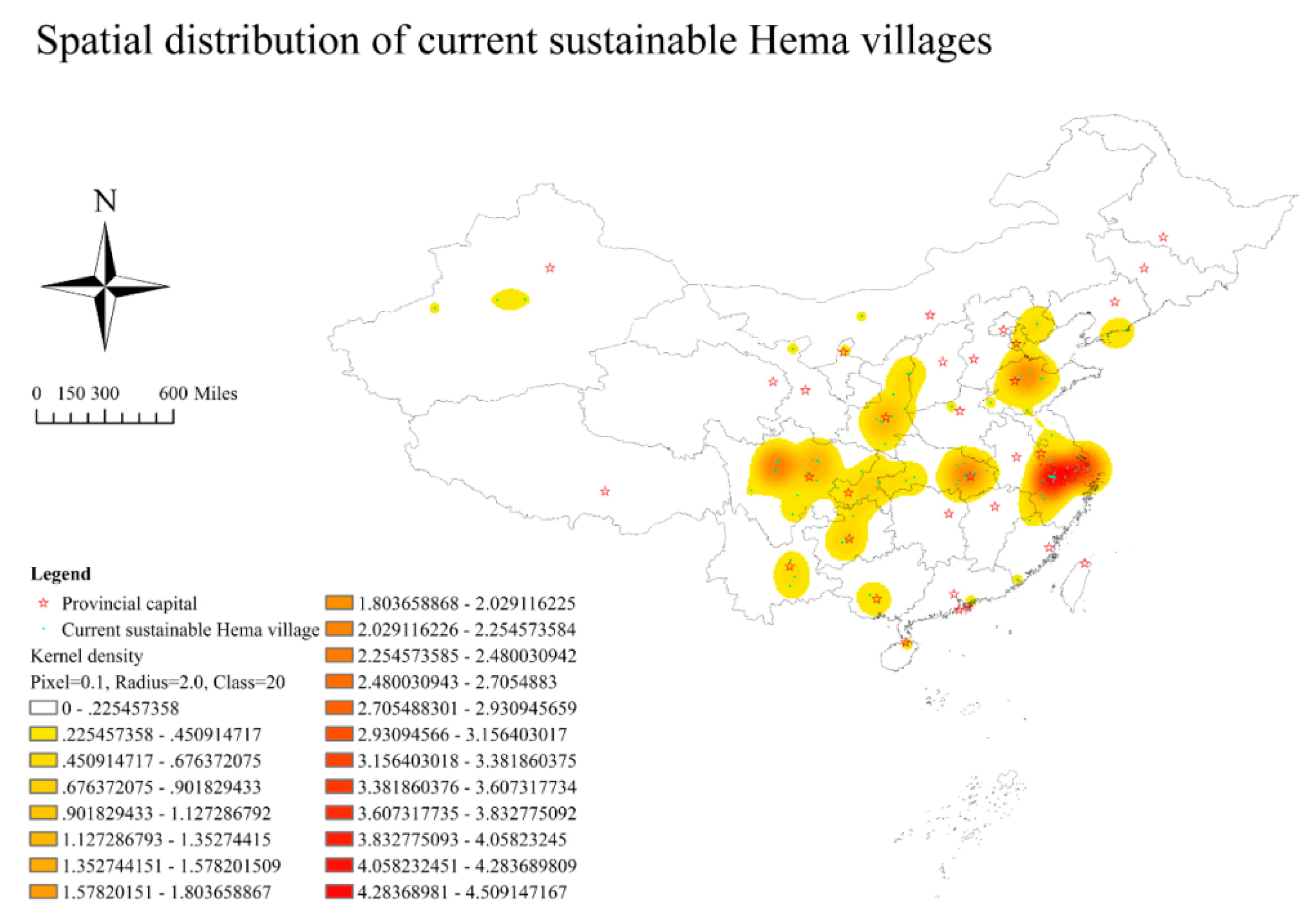
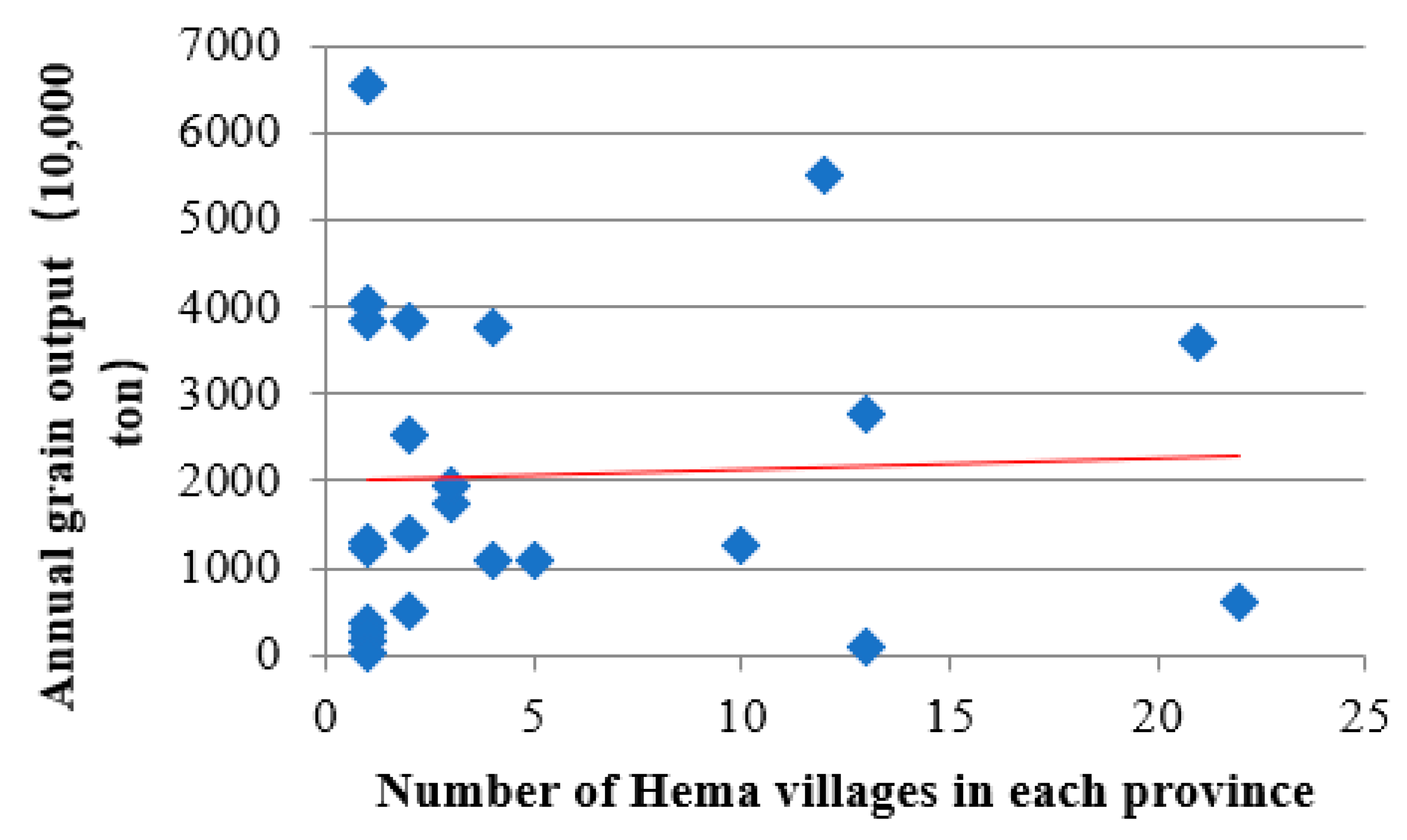
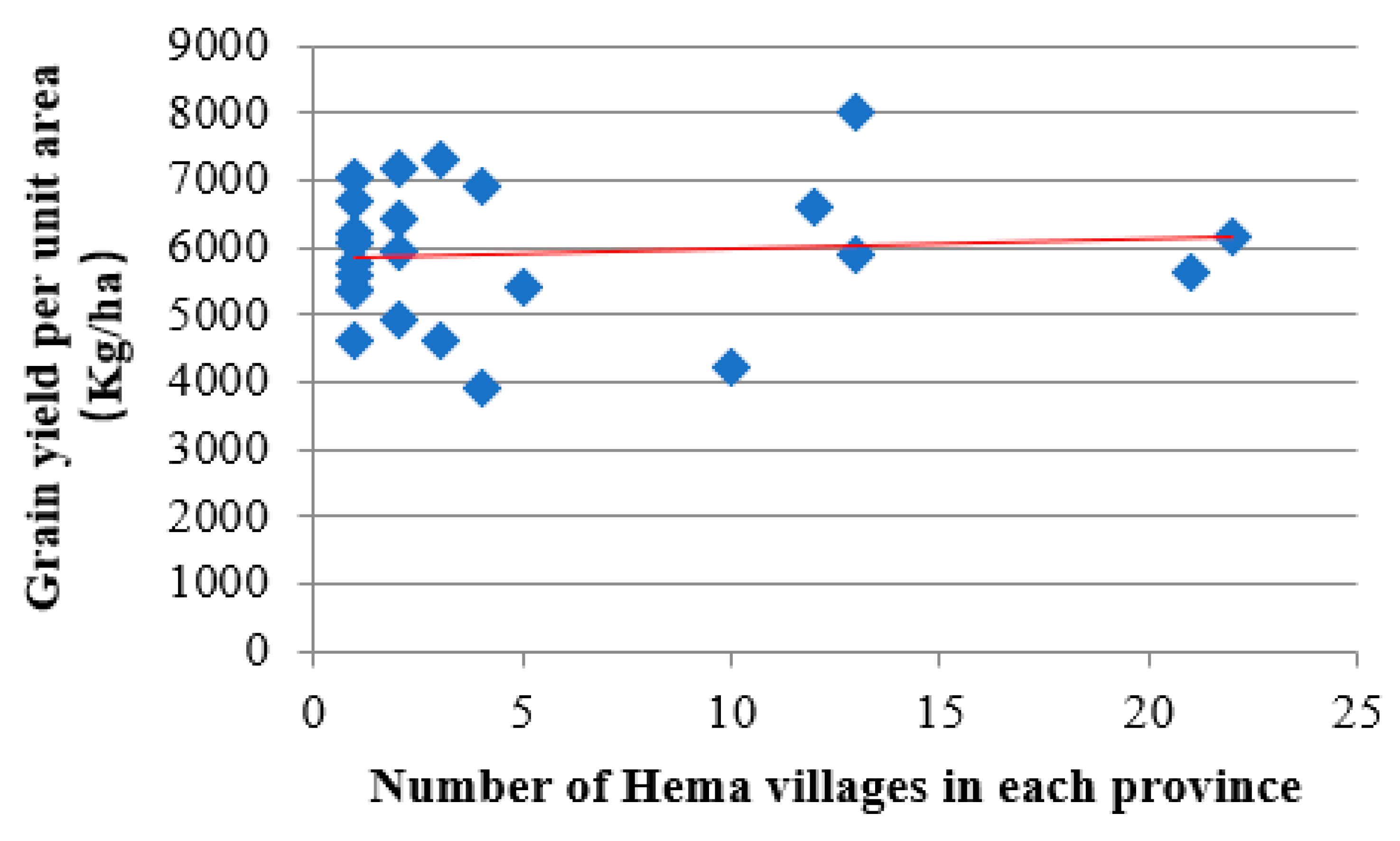
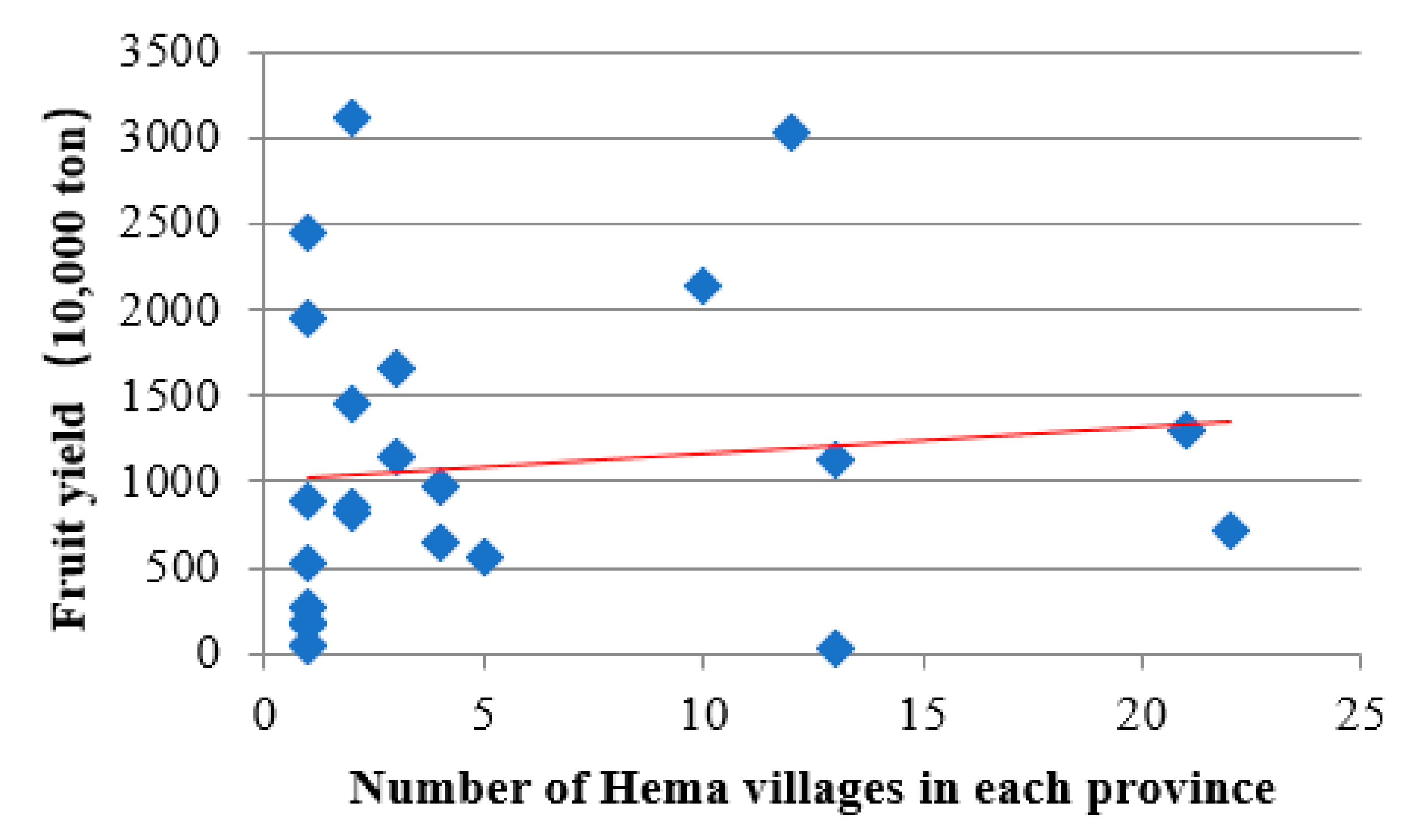
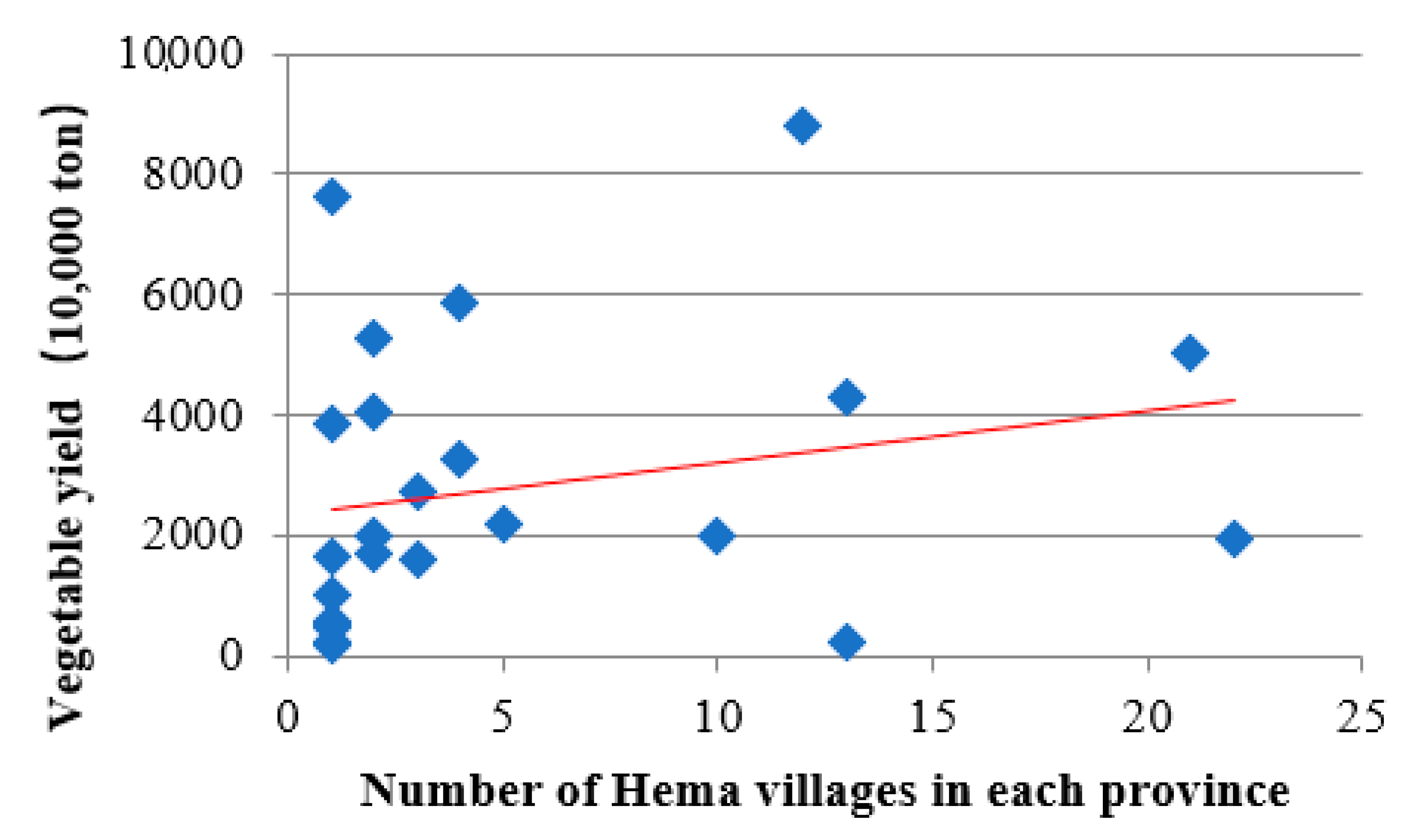
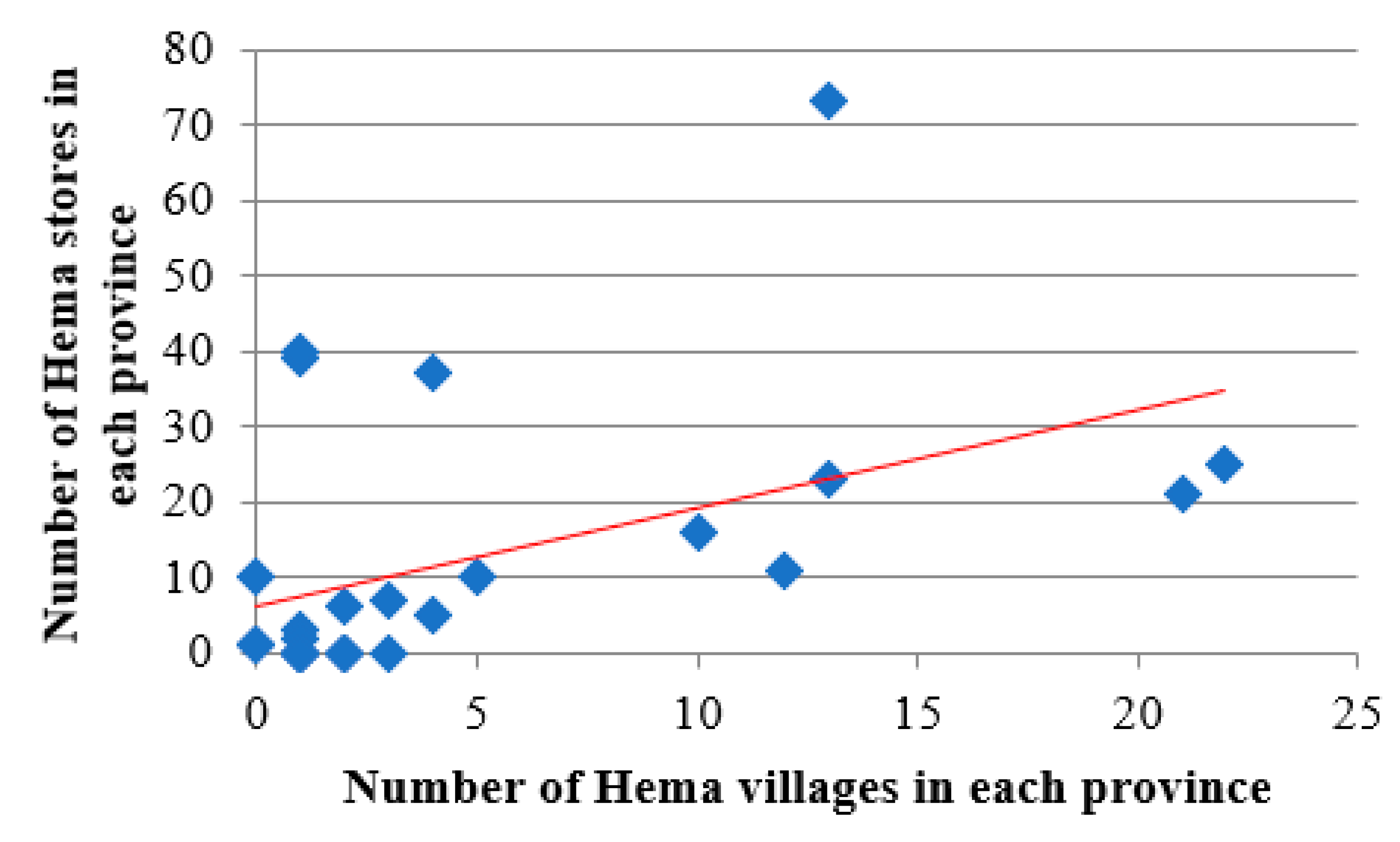
| Village | Longitude/(°E) | Latitude/(°N) | Town | County | City | Province |
|---|---|---|---|---|---|---|
| Bake | 101.989872 | 30.950581 | Moerduoshan | Danba | Ganzi | Sichuan |
| Pengjiazhuang | 114.082188 | 30.719516 | Baiquan | Dongxihu | Wuhan | Hubei |
| Changda | 121.575007 | 31.035705 | Hangtou | Pudong | Shanghai | Shanghai |
| Name | Grain Output | Grain Unit Output 1 | Fruits | Vegetables | Freshippo Stores |
|---|---|---|---|---|---|
| Gradient | 14.2083 | 14.4625 | 15.3991 | 86.1542 | 1.3012 |
| y-intercept | 1984.2397 | 5834.2235 | 1005.5583 | 2342.5298 | 6.1015 |
| Ratio | 0.0072 | 0.0025 | 0.0153 | 0.0367 | 0.2133 |
| PPMCC | −0.0058 | 0.0823 | 0.1222 | 0.2190 | 0.4599 |
| p value | 3.6113 × 10−8 | 1.0432 × 10−35 | 3.8405 × 10−8 | 4.19342 × 10−8 | 0.0416 |
| R squared | 0.0072 | 0.0025 | 0.0153 | 0.0367 | 0.2115 |
Disclaimer/Publisher’s Note: The statements, opinions and data contained in all publications are solely those of the individual author(s) and contributor(s) and not of MDPI and/or the editor(s). MDPI and/or the editor(s) disclaim responsibility for any injury to people or property resulting from any ideas, methods, instructions or products referred to in the content. |
© 2023 by the authors. Licensee MDPI, Basel, Switzerland. This article is an open access article distributed under the terms and conditions of the Creative Commons Attribution (CC BY) license (https://creativecommons.org/licenses/by/4.0/).
Share and Cite
Peng, X.; Wang, G.; Chen, G. Spatial Distribution of Freshippo Villages under the Digitalization of New Retail in China. Sustainability 2023, 15, 3292. https://doi.org/10.3390/su15043292
Peng X, Wang G, Chen G. Spatial Distribution of Freshippo Villages under the Digitalization of New Retail in China. Sustainability. 2023; 15(4):3292. https://doi.org/10.3390/su15043292
Chicago/Turabian StylePeng, Xing, Guoen Wang, and Guojun Chen. 2023. "Spatial Distribution of Freshippo Villages under the Digitalization of New Retail in China" Sustainability 15, no. 4: 3292. https://doi.org/10.3390/su15043292
APA StylePeng, X., Wang, G., & Chen, G. (2023). Spatial Distribution of Freshippo Villages under the Digitalization of New Retail in China. Sustainability, 15(4), 3292. https://doi.org/10.3390/su15043292






